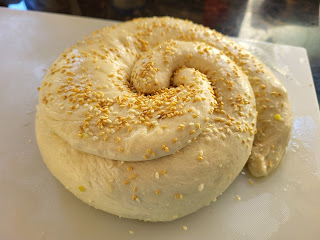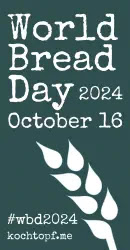Even though I love sourdough, I do have a few issues with
it. First, it’s unpredictability (for
me). I never know if it’s going to
actually work and result in a decent loaf.
Second, the maintenance. Since I’ve
drastically cut back on baking (carb reduction), it feels wasteful to me to
feed and discard starter everyday, so I mostly rely on yeasted breads.
However, I recently read about a technique that was
unfamiliar to me: yeast water. This is a different method of producing
sourdough breads without the waste, so I decided to give this a try. Be warned! It does take some time and patience. But the end result is a lovely, not-too-sour sourdough
bread. I decided to share this technique
for the October challenge, and I’m looking forward to reading about everyone’s
results.
The method I used can be found on the King Arthur Baking
website, but I will describe it below, along with my experience and photos.
Basically, a mixture of fruit and water (with a bit of
sugar and salt) is left to ferment for about a week. Once it is made, it can be stored in the
refrigerator. It doesn’t require any
daily feeding; there is no discard (a possible negative for some) and no wasted
flour. When you want to make bread, you
just mix the yeast water with some flour and let it sit overnight.
King Arthur’s recipe is based on a process by Pablo Giet, a
German baker in San Rafael, California.
If you’re interested in his method, he does have a video explaining
everything, “Pablos
ultimate yeastwater.”
Step one:
Start
by finding a jar or bottle that will hold at least 32 ounces, preferably more
like 34 ounces (though 32 ounces will do in a pinch). I ended up using a glass
jar that had held vinegar.
Use
a funnel to put 500g (2 1/4 cups) of tap water, 50g (1/4 cup) of granulated
sugar, and two dried dates (pitted or whole) into the jar.
Step
two:
Screw
the cap on the jar and shake vigorously to dissolve the sugar. Loosen the cap a
half-turn and put the bottle somewhere warm; 78.8°F is optimal. I ended up
putting it my turned-off oven with the light on.
Step
three:
For the next 4 days you’re going to shake the bottle twice a day.
Unscrew the cap to let out any pressure buildup, screw it back on, then shake
it well.
After 24 hours you should already be seeing some bubbles.
By the end of 4 days, the water should be frothy on top, and
you’ll definitely be able to smell the fruit fermenting: think a combination of
orchard and barroom.
Step four:
On
day 5, add the following to the bottle:
- 1
dried date
- 5g (1
teaspoon) salt
- 20g
(1 1/2 tablespoons) granulated sugar
- 400g
(1 3/4 cups) water
This
is where you might have trouble with a 32-ounce bottle. Adding 400g of water
takes you up to about 31 3/4 ounces plus the space the dates take up, so in
order to leave a little headspace at the top for bubbles and shaking, you’ll
probably have to back off on the water a bit. I actually added just 360g (about
1 1/2 cups) of water (10% less). The missing 10% didn’t make a difference in
the final outcome.
Shake
the bottle vigorously to dissolve the sugar. Put it back in its warm spot, and
shake twice a day, uncapping and recapping each time, for 4 more days.
After
8 days, you’re ready to build your final starter and make bread.
Step
5:
Time
for bread!
Build
a starter by combining yeast water and flour in equal parts (by weight). For my test recipe, I used Naturally
Leavened Sourdough Bread. I halved
the recipe, making just one test loaf, so I combined 113.5 g of yeast water with
113.5 g of all-purpose flour in a small bowl.
I covered the bowl with plastic wrap, set it my turned-off oven with the
light on, and let it rest for 16 hours (from 5 pm to 9 am the next morning).
After that 16 hour period, the starter was bubbly and stretchy.
Then
I followed the bread recipe as written.
I actually added extra time to the proofing process, maybe an extra 60
to 90 minutes. After making bread for so
many years, I find that times are just guidelines and sometimes it just takes
longer for these kinds of doughs, so use your experience to guide you!
Step
6:
Time
to shape the dough. I gathered up the
dough, shaped it into a round and placed it into a well-floured brotform for
the next rise, which, again, took longer than the recipe guidelines. During the last 30 minutes or so, I preheated
my oven to 450˚F.
Now,
I have to admit that I made this loaf twice.
The first time, I didn’t keep my yeast water in a consistently warm
place, and I suspect its potency wasn’t as strong. I also put the loaf on a piece of parchment
paper on a sheet pan as per the recipe, and, since it’s a soft dough, it spread
more than I would have liked.
So,
I made it a second time.
This time I
actually followed the instructions, kept the yeast water in the oven and placed
the brotform in the oven until I had to do the preheating. Instead of placing the loaf on a sheet pan, I
heated up my Dutch oven at the same time, and used that as my baking vessel. I
baked it for 20 minutes with the lid on, then removed the lid for the final 15
minutes. This tactic was successful, because I ended up with a nicely shaped
and cooked loaf of bread.
Transfer
the loaf to a cooling rack, and let cool completely before slicing.
Step
7:
Maintaining
the yeast water. Each bottle will make
several loaves of bread, but, if you want to continue baking with this method,
you will need to keep it going. Make
sure to save 200 g of yeast water.
Combine
the 200 g with700 g of tap water (might be less because of the volume of the
bottle), 35 g of sugar, 3.5 g of salt, and 2 dried dates.
Shake twice a day
for 2 to 3 days, until the yeast water is foaming nicely. Strain out the dates,
and store water in the refrigerator.
For my final
experiment, I chose an arbitrary recipe as a guinea pig: a Red Onion and Green Olive Focaccia from Sourdough Everyday by Hannah Dela
Cruz. I used the yeast water straight
from the refrigerator, mixing equal weights of water and flour, then placed it
the turned-off, light-on oven for 16 hours.
In the morning it was bubbly and stretchy, so I proceeded with the
focaccia, once again using my experience as a guideline for proofing times. The dough became wonderfully bubbly and soft,
better than I’d ever created before. I
placed the dough in the fridge overnight, and baked it the next day. It was a successful experiment!
Now, I feel I can
join in with future sourdough bakes with this technique. I hope you will give it a try even if you’re
a current sourdough starter user. Use
the King Arthur recipe, or experiment with another one that is either a
familiar favorite or brand new.
Resources
https://makeitdough.com/creating-fruit-yeast-water/
https://www.kingarthurbaking.com/blog/2020/02/24/baking-bread-with-a-yeast-water-starter
https://www.rosemarymark.com/yeast-water-artisan-bread-2/
https://drivemehungry.com/yeast-water/
I also experimented with a recipe for Rye Sourdough. This was a three- to four-day process. The first time around, both starters bubbled beautifully, but I don't think I let the final dough proof long enough because the texture was extremely fine-grained. So, I made it a second time and just let the dough call the shots. The final proof went 24 hours! Better texture this time, but not perfect. It was also noticeably sour in flavor.
I think the recipe itself has an issue, because the dough is rock solid. I suspect it should be more wet and soft. Poor little yeastie beasties had a difficult time making this very firm dough form those lovely bubbles. I will continue searching for other recipes and keep in mind the texture of the final dough before baking.
Check out the blogs of the other Babes to see how they fared.
If you're interested in giving this technique a try, let me know!











































